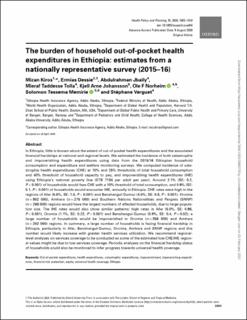| dc.description.abstract | In Ethiopia, little is known about the extent of out-of-pocket health expenditures and the associated financial hardships at national and regional levels. We estimated the incidence of both catastrophic and impoverishing health expenditures using data from the 2015/16 Ethiopian household consumption and expenditure and welfare monitoring surveys. We computed incidence of catastrophic health expenditures (CHE) at 10% and 25% thresholds of total household consumption and 40% threshold of household capacity to pay, and impoverishing health expenditures (IHE) using Ethiopia's national poverty line (ETB 7184 per adult per year). Around 2.1% (SE: 0.2, P < 0.001) of households would face CHE with a 10% threshold of total consumption, and 0.9% (SE: 0.1, P < 0.001) of households would encounter IHE, annually in Ethiopia. CHE rates were high in the regions of Afar (5.8%, SE: 1.0, P < 0.001) and Benshangul-Gumuz (4.0%, SE: 0.8, P < 0.001). Oromia (n = 902 000), Amhara (n = 275 000) and Southern Nations Nationalities and Peoples (SNNP) (n = 268 000) regions would have the largest numbers of affected households, due to large population size. The IHE rates would also show similar patterns: high rates in Afar (5.0%, SE: 0.96, P < 0.001), Oromia (1.1%, SE: 0.22, P < 0.001) and Benshangul-Gumuz (0.9%, SE: 0.4, P = 0.02); a large number of households would be impoverished in Oromia (n = 356 000) and Amhara (n = 202 000) regions. In summary, a large number of households is facing financial hardship in Ethiopia, particularly in Afar, Benshangul-Gumuz, Oromia, Amhara and SNNP regions and this number would likely increase with greater health services utilization. We recommend regional-level analyses on services coverage to be conducted as some of the estimated low CHE/IHE regional values might be due to low services coverage. Periodic analyses on the financial hardship status of households could also be monitored to infer progress towards universal health coverage. | en_US |

